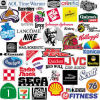 It’s Saturday and we’re about to go out for dim sum. I guess that means I should clear out the links that didn’t really form into coherent themes of three or more articles:
It’s Saturday and we’re about to go out for dim sum. I guess that means I should clear out the links that didn’t really form into coherent themes of three or more articles:
- The Paper It’s Printed On. The magazine business is one of razor-thin profits, if any. Time Magazine’s answer to saving money: going to thinner paper in the magazine. Of course, so as not to offend advertisers, they are using different stock on the West Coast and East Coast than they are in the center of the country.
- A Hidden Relationship. Here’s a fascinating piece about Clifton’s Cafeteria in downtown Los Angeles… and the mistress of the original owner. Although a very straightlaced Christian, he found what worked for him, and she’ll always be a part of his restaurant.
- The Health Insurance Game. Scientific American this week had a blog piece on the health insurance shell game. The problem is: they got the origin story wrong. Heath insurance was not created to share risk — it is distinctly different than other forms of insurance. Want the real origin story? I strongly recommend the excellent This American Life pieces on health insurance. There you will learn that health insurance was created in 1940s as a way to give employee’s raises (that is, more benefits) while getting around wage limitations from WWII. They were originally marketed by doctor’s groups (Blue Cross) and hospital groups (Blue Shield) as a way to drum up business.
- Broadway News. Neil Patrick Harris will be starring in a Broadway production of “Hedwig and the Angry Inch“. I hope he goes on tour with it (or at least to Los Angeles).
- Little Girls, Little Girls. Speaking of Broadway, in Annie Miss Hannigan sings of her hatred for little girls. Does Disney hate little girls? Well, other than loving their parent’s money, that is? Perhaps — for in addition to all the problems with Disney princesses, there are concerns that Disney TV is poisoning the minds of tween girls.
P.S.: I’m beginning to think about a blog post about loss of trust in the government — that is, how we’ve gone from a society that trusted in the good of the government (in the WWII and post-war years) to a society that no longer trusts the government. How did happen, and what were the turning points. If you have something you want me to think about as the subject firms up in my head, please drop me a note.
Music: Chitty Chitty Bang Bang (1968 Soundtrack) (Orchestra): “Chitty Chitty Bang Bang (Main Title) (Chitty Chitty Bang Bang & The Roses of Success)”


 To close out the week, here’s a late lunch post to really chew on — some food news that caught my eye:
To close out the week, here’s a late lunch post to really chew on — some food news that caught my eye: This week, everyone’s been upset with the NSA because of all the recent disclosures. So I thought I would share with you a story of something good that came from the NSA (well, at least most people think it is good). What prompted this story was
This week, everyone’s been upset with the NSA because of all the recent disclosures. So I thought I would share with you a story of something good that came from the NSA (well, at least most people think it is good). What prompted this story was 
 Today’s (not quite) lunchtime post is a collection of news articles about various corporations that have caught my eye:
Today’s (not quite) lunchtime post is a collection of news articles about various corporations that have caught my eye: One of the lead articles at the LA Times today is on
One of the lead articles at the LA Times today is on  This morning, while reading
This morning, while reading  Having just posted the highway page updates*, it’s time to start collecting headlines again. Of course, by the time you read this, the updates will be two weeks old… but “whatever”:
Having just posted the highway page updates*, it’s time to start collecting headlines again. Of course, by the time you read this, the updates will be two weeks old… but “whatever”: Let me tell you about my Father’s Day… but first, a shout out to my father who passed away in 2004.
Let me tell you about my Father’s Day… but first, a shout out to my father who passed away in 2004.